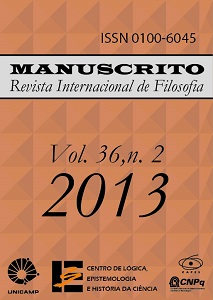Resumo
En este artículo proponemos una explicación novedosa del efecto Knobe. El efecto Knobe es una asimetría peculiar en la atribución de intencionalidad a un agente con relación a los efectos colaterales previstos de su acción, dependiendo sólo de la valoración moral del efecto y sin que nada más cambie en la situación juzgada: los efectos colaterales malos, pero no los buenos, se consideran intencionalmente producidos. Nos enfocamos aquí en la pregunta por la explicación de esa peculiar asimetría: ¿basta la valencia moral del efecto colateral para explicarla? Hacemos un análisis sistemático de una gran variedad de viñetas presentes en los estudios experimentales y de sus resultados. Intentamos así aislar los factores explicativos. Proponemos que la asimetría se explica por concordancia o discordancia entre la valencia moral del efecto colateral y la actitud moral del agente, juzgada por los espectadores.
Abstract:
In this article we discuss factors presumably responsible for the Knobe effect and offer a novel explanation. The Knobe effect refers to a peculiar asymmetry in attributions of intentionality to the foreseen side-effects of an action, depending only on their moral assessment and with no other changes in the circumstances: the bad effects, but not the good ones, are considered intentionally produced. We focus on the possible explanation: does the moral value of the effect explain the asymmetry? We analyze a variety of vignettes introduced in experimental studies and their results, trying to isolate the explanatory factors. We propose that a concordance or discordance between the moral valence of the side effect and the moral attitude of the agent, as judged by spectators, explains the asymmetry.
Keywords: Intentionality. Knobe-effect. Free-rider. Moral judgment. Harm-morality. Public goods.
Referências
BRATMAN, M. “Two faces of intention”. Philosophical Review, 93 (3) pp. 375-405, 1984.
COVA, F., NAAR, H. “Side-Effect effect without side effects: The pervasive impact of moral considerations on judgments of intentionality”. Philosophical Psychology 25 (6) pp. 837-854, 2012a.
COVA, F., NAAR, H. “Testing Sripada's Deep Self model”. Philosophical Psychology 25 (5) pp. 647 – 659, 2012b.
HARMAN, G. “Practical Reasoning”. Review of Metaphysics, 29 pp. 431– 63, 1976.
HINDRIKS, F. “Intentional action and the praise-blame asymmetry”. Philosophical Quarterly 58 (233) pp. 630-641, 2008.
HOLTON, R. “Norms and the Knobe Effect”. Analysis 70 (3) pp. 1-8, 2010.
KNOBE, J. “Intentional action and side effects in ordinary language”. Analysis 63 (3) pp. 190–194, 2003.
KNOBE, J. “The concept of intentional action: A case study in the uses of folk psychology”. Philosophical Studies 130 (2) pp. 203-231, 2006.
KNOBE, J., BURRA, A. “The folk concepts of intention and intentional action: A cross-cultural study”. Journal of Cognition and Culture 6 (1-2) pp. 113-132, 2006.
KNOBE, J., MENDLOW G. “The good, the bad, and the blameworthy: Understanding the role of evaluative considerations in folk psychology”. Journal of Theoretical and Philosophical Psychology 24 pp. 252–258, 2004.
KOLLOCK, P. “Social Dilemmas: The Anatomy of Cooperation”. Annual Review of Sociology 24 pp. 183-214, 1998.
LANTERI, A. “Judgments of intentionality and moral worth: Experimental challenges to Hindriks”. Philosophical Quarterly 59 (237) pp. 713-720, 2009.
LESLIE, A., KNOBE, J., COHEN, A. “Acting intentionally and the side-effect effect: 'Theory of mind' and moral judgment”. Psychological Science 17 pp. 421-427, 2006.
MACHERY, E. “The folk concept of intentional action: Philosophical and experimental issues”. Mind and Language 23 (2) pp. 165–189, 2006.
MALLON, R. “Knobe vs. Machery: Testing the trade-off hypothesis”. Mind and Language 23 (2), pp. 247-255, 2008.
McCANN, H. “Intentional Action and Intending: Recent Empirical Studies”. Philosophical Psychology, 18 (6), pp. 737-748, 2005.
MELE, A. “Intentional action: Controversies, data, and core hypotheses”. Philosophical Psychology,16 (2), pp. 325-340, 2003.
NADELHOFFER, T. “On praise, side effects, and folk ascriptions of intentionality”. Journal of Theoretical and Philosophical Psychology, 24 (2), pp. 196-213, 2004,.) NADO, J. “Effects of moral cognition on judgments of intentionality”. British Journal for the Philosophy of Science, 59 (4), pp. 709-731, 2008.
PHELAN, M., SARKISSIAN, H. “The folk strike back; or, why you didn't do it intentionally, though it was bad and you knew it”. Philosophical Studies, 138 (2), pp. 291 – 298, 2008.
PHELAN, M., SARKISSIAN, H. “Is the 'trade-off hypothesis' worth trading for?” Mind and Language, 24 (2), pp. 164-180, 2009.
ROSE, D., LIVENGOOD, J., SYTSMA, J., MACHERY, E. “Deep trouble for the deep self”. Philosophical Psychology, 25 (5), pp. 629 – 646, 2011.
SRIPADA, C. “Mental State Attributions and the Side-Effect Effect”. Journal of Experimental Social Psychology, 48 (1), pp. 232-238, 2012.
SRIPADA, C., KONRATH, S. “Telling More Than We Can Know About Intentional Action”. Mind and Language, 26 (3), pp. 353- 380, 2011.
TRIVERS, R., “The evolution of reciprocal altruism”. Quarterly Review of Biology, 46 (1), pp. 35–57, 1971.
YOUNG, L., CUSHMAN, F., ADOLPHS, R., TRANEL, D., HAUSER, M. “Does emotion mediate the effect of an action's moral status on its intentional status? Neuropsychological evidence”. Journal of Cognition and Culture, 6, pp. 291-304, 2006.

